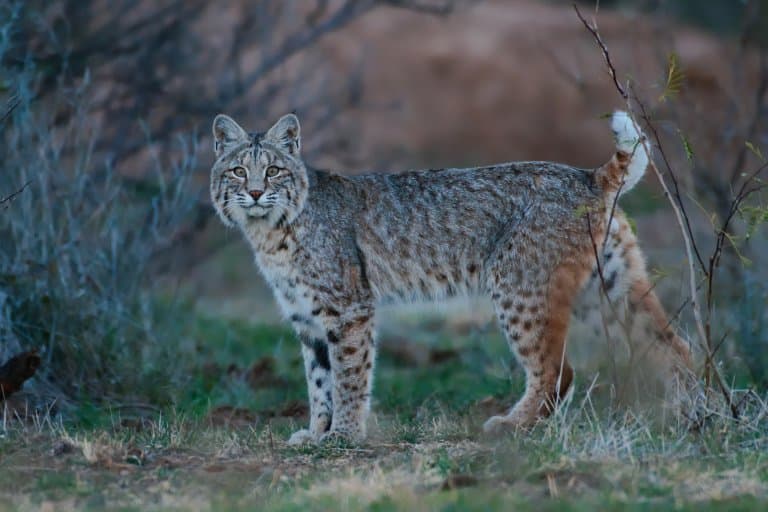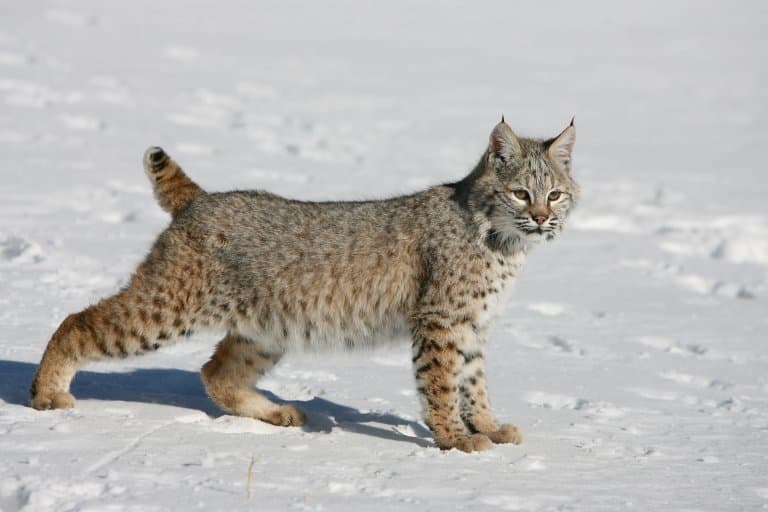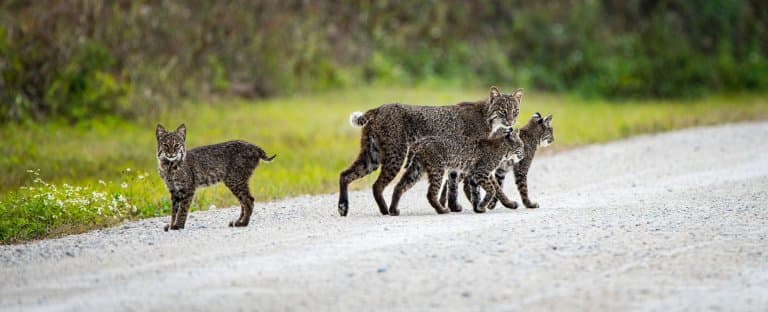Bobcat Profile
On the entire North American continent, few predators are as versatile as the bobcat.
Able to hunt in almost every landscape, at any time of the day or night, and to bring down prey of any size, wherever they may be hiding, these are one of the world’s most adaptable cats.
Not to be confused with their larger cousins, the lynx, these smaller cats pack an enormous punch.

Bobcat Facts Overview
| Habitat: | Diverse: woodland, desert, urban and swamp |
| Location: | USA, Canada, Mexico |
| Lifespan: | 10 years in the wild, 32 years in captivity |
| Size: | 125 cm (49 inches) long |
| Weight: | Up to around 20 kg (44 lb) |
| Color: | Grayish-brown, black streaks |
| Diet: | Insects, reptiles, fowl, rodents, rabbits, deer |
| Predators: | Sometimes coyotes, wolves, large raptors, humans |
| Top Speed: | 48 kph (30 mph) |
| No. of Species: |
1 |
| Conservation Status: |
Least Concern |
The bobcat is also known as the red lynx and it ranges from southern Canada to Mexico, inhabiting diverse landscapes such as woodlands, deserts, urban edges and even swamplands.
There are two subspecies of bobcat: one east of the Great Plains, and the other west of the Great Plains. It’s the smallest of the Lynx genus, and grows to about twice the size of a domestic cat – an average of around 83 cm (33 inches) in length and 9.6 kg (21 lb) in weight.
Bobcats are so important to the health of the ecosystem. Their versatility allows them to keep several populations in check at once, and their ranges are divided neatly into territories to be respected by their peers.
They prey on a variety of animals depending on their location, such as rabbits, hares, rodents, deer, fish and even insects. They are able to go without food for long periods, and are capable of preying much larger animals if necessary, such as sheep, and livestock. Incredibly, a photographer even caught a bobcat dragging a shark from the ocean in Florida in 2014.
While they have several competitors, they have almost no equals and despite being small, they are particularly fierce. They’re generally quiet, but can make mythical noises and while they’re still hunted, their adaptability means they’re still going strong.
Interesting Bobcat Facts
1. Their name is derived from their tail
Bobcats have a black-tipped stubby little tail, or ‘bobbed’ tail from which they get their name. It reaches around 50 inches in length, and is shorter than many big cats tails.
The tail’s coloring is different to that of the lynx which is in the same genus: the tip of the lynx’s tail is completely black, while the underside of a bobcat’s tail is white.

2. They are territorial
Being a solitary animal, the bobcat is quite adamant about where its home is. It’s difficult to defend a large territory as a single animal and this one uses several sign-posting strategies to make it clear.
Some are visual, like claw marks on trees. Some are scent-based, using specially-adapted glands, and some are as no-nonsense as a big old poo right on the boundary.
This may work against other bobcats, but the much larger lynx may or may not take heed of the warnings. 1
3. Lynx are a major competitor
The Canada lynx, despite being in the same genus as the bobcat, is big enough to pose a significant threat. Not only do they occupy similar niches – feeding on the same sort of prey – but they will occasionally get into scraps.
Lynx are better suited to deep snow, with enormous feet, which you’d think would put them at an advantage, but bobcats bring their own special adaptations to the fight.
Being the smaller of the two, the bobcat compensates for this by being significantly more aggressive. Fights aren’t super common, but they’re often surprisingly even when they do occur. 2

4. They make weird noises
Bobcats don’t say much, but when they do talk, it’s very unsettling. During mating season in February and March, they’ll emit a cacophony of hissing, yowling, and wailing.
It’s thought that bobcats may have been the origin of numerous woodland myths such as babies being left by witches in the forest.
Their peculiar wail often sounds like a child crying or a woman screaming, which makes them all the more terrifying to encounter at night. 3
5. Bobcat pelts are still popular
Despite having been hunted for generations, bobcat numbers are still good. These are incredibly versatile and successful predators, able to eat pretty much anything, and have shown a resilience in their populations that many animals can’t.
A boom in bobcat numbers in New Mexico came from increased hunting of one of their other major competitors: the coyote. Still, the general trend in population figures is negative, and hunting and trapping play a role in this.
Bobcat pelts are legally harvested in 39 US states, with CITES involvement. This is still a bit of a grey area, however, as the North American Model of Wildlife Conservation seems to overlook fur markets in general as a result of this involvement. 4
6. They’re phenomenal hunters
One of the most significant capabilities of the bobcat, one that’s kept them out of the vulnerable species categories for so long, is their incredible capacity to hunt almost anything.
A bobcat can bring down a large deer almost as easily as it can steal a domesticated chicken. In fact, they are capable of bringing down animals up to eight times their size.
As ambush predators, they play a significant role in population control. They hunt insects, rats, snakes, birds, waterfowl, goats, and even large deer.
Their hearing and vision are particularly attuned to nocturnal hunting, and they can swim as well as they can climb.
Very little can survive a bobcat attack; despite their small size, they’re surprisingly powerful. This, coupled with their increased aggression allows them to defend against wolves and mountain lions too.
7. They keep their footsteps quiet when hunting
Bobcats will place their hind feet in the same place where their front feet had been. This is thought to help them reduce noise when hunting prey.
It also means that their paw tracks look like a two-legged animal.
8. They are rodent police
This population control deserves emphasising. Populations in the Sonoran Desert feed primarily on rodents and rabbits, animals that reproduce very quickly.
Without the presence of these predators, rodent populations would explode, causing significant harm to the ecosystem and significantly diminishing the biodiversity in the region.
For this reason, bobcats are keystone species: animals that have a powerful effect on the health of their ecosystem and the animals and plants within it.

9. They are crepuscular
In general, bobcats are mostly active in the twilight hours. Around dawn and dusk, they can use the low light to ambush animals who may not be fully awake or as well-adapted to seeing in the dark.
This is known as being crepuscular and it’s common in predators for this reason. However, in many cases, it’s also a product of a lack of rigorous research. Since humans can’t see well in the dark, a lot of nocturnal behaviour of animals goes unrecorded.
More recently, the night-time activity of predators is being revealed with better cameras and tracking methods. It’s now understood that the bobcat is just as capable at night as it is in the early and late hours of the day.
They’ll commonly patrol 3 to 11 km (2-7 miles) a night looking for food.
But they’re not limited to these times, either! During Winter and Autumn, when their main prey sources become more active in the day, bobcats follow suit. 5
10. Female raise young alone
Female bobcats seek out a secluded den, such as cave, or hollow log in which to raise their young.
They have between one and six kittens – but usually two to four, which stay with the mother for up to a year. The mother looks after them, keeping them safe and fed, and teaching them how to hunt.
When something happens to the mother during this period, it has been known for domestic cats to care for orphaned bobcat kittens.

11. There are lynx-bobcat hybrids
In 2004, researchers found the first evidence of the presence of lynx-bobcat hybrids in the wild.
These are known as blynx or lynxcat.
It’s thought this can occur naturally where a lynx or bobcat cannot find a member of its own species for mating. Researchers found that all hybrids had lynx mothers. 6
12. They are represented in folklore
The bobcat is subject to cultural, mythological and spiritual meaning for natives in North America.
The bobcat is twinned with the coyote in Native American mythology to represent the theme of duality.
They are associated with fog and wind, two elements that represent opposites in Amerindian folklore.
Bobcat Fact-File Summary
Scientific Classification
| Kingdom: | Animalia |
| Phylum: | Chordata |
| Class: | Mammalia |
| Order: | Carnivora |
| Family: | Felidae |
| Genus: | Lynx |
| Species Name: |
Lynx Rufus |
Fact Sources & References
- “Bobcat“, Washington Department of Fish & Wildlife.
- ISEC (2014) “Bobcat“, International Society for Endangered Cats (ISEC) Canada.
- Mark L Elbroch et al. (2017) “Contrasting Bobcat Values“, Research Gate.
- Gary Lee Nunley (1978), “PRESENT AND HISTORICAL BOBCAT POPULATION TRENDS IN NEW MEXICO AND THE WEST“, University of Nebraska.
- “Bobcat“, Pennsylvania Game Commission.
- Schwartz, M.K., Pilgrim, K.L., McKelvey, K.S. et al (2004), “Hybridization Between Canada Lynx and Bobcats: Genetic Results and Management Implications“, SpringerLink.
